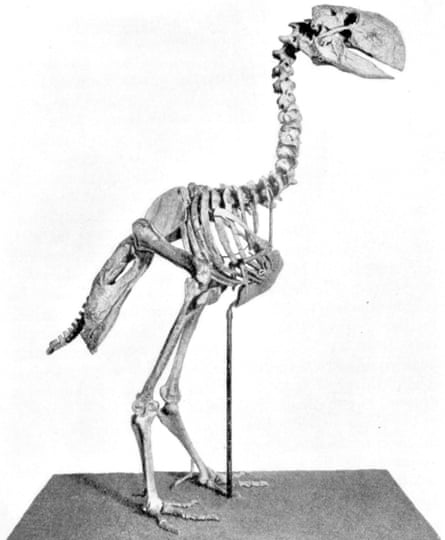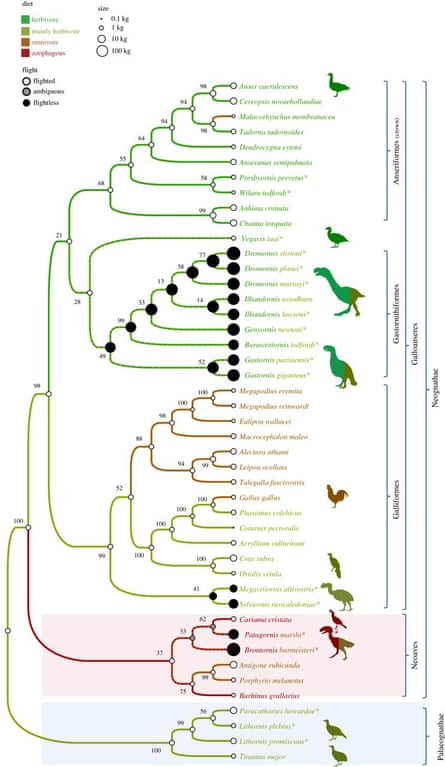We don’t generally think of chickens and ducks as particularly awe-inspiring birds. Kept across the world as pets or as a food source, chickens (Galliformes) and ducks and geese (Anseriformes) are ubiquitous and seen as docile and unintimidating. The comparative anatomist Thomas Huxley noted in 1867 that Galliformes and Anseriformes shared a number of anatomical features, suggesting that the two groups of birds must be related. Later morphological and molecular studies confirmed their close relationship, and all fowl are now grouped in Galloanserae. Galloanserae are considered one of the most primitive groups of modern birds, and their ancestry can be traced back to the time of the dinosaurs. In contrast to their cuddly modern cousins, early fowl were truly giants by avian measures, and included the largest birds on Earth during the Paleogene.
There are several groups of enormous, extinct terrestrial birds that are considered part of Galloanserae. One of them is the Dromornithidae, or Thunderbirds, from Australia. These giant flightless birds lived from the Oligocene until the Pleistocene and formed part of Australia’s megafauna (Worthy & Holdaway, 2002). Some dromornithids reached colossal size, such as Bullockornis, nicknamed the Demon Duck of Doom, which likely stood 2.5 metres tall.
Across Eurasia, the giant bird niche was taken by the Gastornithidae, which ranged from the Paleocene to the Eocene. Three species of these large, flightless birds with strong legs and massive beaks are known from Europe. A species from North America, formerly known as Diatryma gigantea, is now considered to be the fourth species of Gastornithidae. With their giant beak and powerful legs, a peculiar anatomy amongst birds, Gastornithidae were long considered to be carnivores, possibly preying on contemporaneous small horses (Witmer & Rose, 1991). However, as the beaks lack hooks typical for carnivorous birds, and calcium isotopes in the bones do not support a meat-based diet (Angst et al., 2014), it is now assumed that gastornithids were herbivores.
Disentangling the relationships of animals that lived 30m years ago, and of which sometimes only fragmentary skeletons remain, is challenging. What makes things even more complicated in the case of these colossal birds is that they all display massive hind limbs and reduced wings. On first glance, this aligns them with other groups that show this prominent morphology, such as the elephant birds from Madagascar, the moa from New Zealand and the modern-day ratites (ostriches, emus and allies). And indeed, for a long time, Dromornithidae were considered to be closely related to ratites (for instance, Rich, 1979). However, closer examination of the skulls of dromornithidae showed that they were not part of ratites after all.

But where did these behemoths belong? Studies based on morphological datasets of the whole skeleton subsequently placed Dromornithidae, as well as Gastornithidae, as sister groups to Anseriformes (Andors, 1992; Agnolin, 2007), whereas others (Murray & Vickers-Rich, 2004) found that Dromornithidae were part of Anseriformes. It has also been suggested that Dromornithidae, together with the Sylviornithidae from New Caledonia, are sister groups to Galloanserae as a whole (Mayr, 2011). And then there is the case of the South American terrorbirds (Phorusracidae), another group of enormous, terrestrial birds with heavy bills who in certain analyses are placed within Anseriformes (Degrange et al., 2015).
Although it is now clear that Dromornithidae, Gastornithidae and Sylviornithidae are close to Galloanserae, their exact positions with regard to this group remains unclear. Are they in, or are they out? Resolving the classification of these giant birds is plagued by their convergent morphologies, in this case the massive hind limbs and reduced wings, and often limited sampling of potentially related species. Morphological convergence reflects an adaption to a shared environment rather than a feature derived from a common ancestor. For instance, the elongated set of tail vertebrae in in different groups of diving birds suggests that this morphology is related to the mechanical demands of using the tail as a rudder during underwater foraging (Felice & O’Connor, 2014), rather than common descent.
Grouping species based on morphology when there is a strong suspicion of convergence can result in flawed results. With the rise of molecular phylogenetics, pioneered by Sibley and Ahlquist in 1990, ornithologists have successfully used DNA analyses to resolve bird relationships. Although molecular phylogenetics definitely has its caveats, molecular data have now provided a robust phylogenetic tree for living bird species (for instance, Hackett et al., 2008). These trees are often rather different from those derived from morphological data only, often because of cases of convergence. As convergent morphologies have been the thorn in the side of the avian palaeontologist on a quest to solve the relationships between extinct giant flightless birds and living Galloanserae, Australian bird palaeontologist Trevor Worthy and his team set out to resolve this issue once and for all by combining molecular and morphological data.

Worthy and colleagues collated a large dataset of 290 morphological features for 20 extinct giant flightless birds and 29 living birds. These morphological data were analyzed against a molecular framework that constrained the relationships of the living birds to the relationships that are robustly inferred from molecular data. The data from the fossil birds were then free to find their place on the bird tree as dictated by their morphological similarities to the living species already in place. By constraining the analyses of the fossil taxa in this way, the fossil species are analyzed in the context of a evolutionary framework that, at this point, is the best reconstruction of the evolutionary tree of birds we have, while at the same time also considering the morphology of all skeletal parts.
The analyses showed the presence of four distinct groups within early Galloanserae; Anseriformes, Galliformes, a group formed by Gastornithidae and Dromornithidae together (named Gastornithiformes), and Vegavis (the earliest member of Gallaoanserae dated to 69-66 million years ago, Clark et al., 2016). The Sylviornithidae were found to be part of Galliformes. Phorusrhacidae, the enormous flightless birds from South America, were found to be well outside of Galloanserae and thus unrelated to Dromornithidae and Gastornithidae, as they may be closer to seriemas.
This means that dromornithids are not inside of Anseriformes, but form a separate sister group to fowl, together with the Gastornithidae. Does this mean that the ancestor of chickens and ducks was a large and flightless bird? No. As with ratites, where a volant ancestor repeatedly gave rise to parallel lineages of flightless birds, a small volant early galloansere bird spawned the various species of gastornithids and dromornithids, who subsequently lost the ability to fly. The current new analysis reconstructs the diet of ancestral Galloanserae as herbivorous or mainly herbivorous diet. This suggests that gastornithids, dromornithids and sylviornithids retained a similar diet, despite an almost 100-fold increases in body mass and considerable morphological change.
References
Agnolin, F.L., 2007 Brontornis burmeisteri Moreno & Mercerat, un Anseriformes (Aves) gigante del Mioceno Medio de Patagonia, Argentina. Revista del Museo Argentino de Ciencias Naturales 9, 15–25. (doi:10.22179/REVMACN.9.361)
Andors, A.V., 1992 Reappraisal of the Eocene groundbird Diatryma (Aves: Anserimorphae). In Papers in Avian paleontology honoring Pierce Brodkorb (ed. KE Campbell), Nat. Hist. Mus. Los Angeles County Sci. Ser. vol. 36, pp. 109–125.
Angst D., et al., 2014. Isotopic and anatomical evidence of an herbivorous diet in the Early Tertiary giant bird Gastornis. Implications for the structure of Paleocene terrestrial ecosystems. Naturwissenschaften 101: 313–322.
Clarke, J.A., et al. 2016. Fossil evidence of the avian vocal organ from the Mesozoic. Nature 538, 502–505.
Degrange, F.J., et al., 2015. A new Mesembriornithinae (Aves, Phorusrhacidae) provides new insights into the phylogeny and sensory capabilities of terror birds. Journal of Vertebrate f 35, e912656.
Felice, R.N. & O’Connor, P.M., 2014. Ecology and Caudal Skeletal Morphology in Birds: The Convergent Evolution of Pygostyle Shape in Underwater Foraging Taxa. PLoS ONE9(2): e89737. https://doi.org/10.1371/journal.pone.0089737
Hackett, S.J., et al., 2008. A Phylogenomic Study of Birds Reveals Their Evolutionary History. Science 320: 1763-1768.
Mayr, G., 2011 Cenozoic mystery birds: on the phylogenetic affinities of bony-toothed birds (Pelagornithidae). Zoologica Scripta 40, 448–467.
Murray, P.F. & Vickers-Rich, P., 2004. Magnificent mihirungs: the colossal flightless birds of the Australian dreamtime. Bloomington, IN: Indiana University Press.
Rich, P.V., 1979. The Dromornithidae, an extinct family of large ground birds endemic to Australia. Bureau of National Resources, Geology and Geophysics, Bulletin 184.
Sibley, Charles Gald & Ahlquist, Jon Edward (1990): Phylogeny and classification of birds. Yale University Press, New Haven, Conn.
Witmer, L.M. & Rose, K.D., 1991. Biomechanics of the jaw apparatus of the gigantic Eocene bird Diatryma: implications for diet and mode of life. Paleobiology 17: 95-120.
Worthy, T.H. et al., 2017. The evolution of giant flightless birds and novel phylogenetic relationships for extinct fowl (Aves, Galloanseres). Royal Society Open Science

Comments (…)
Sign in or create your Guardian account to join the discussion